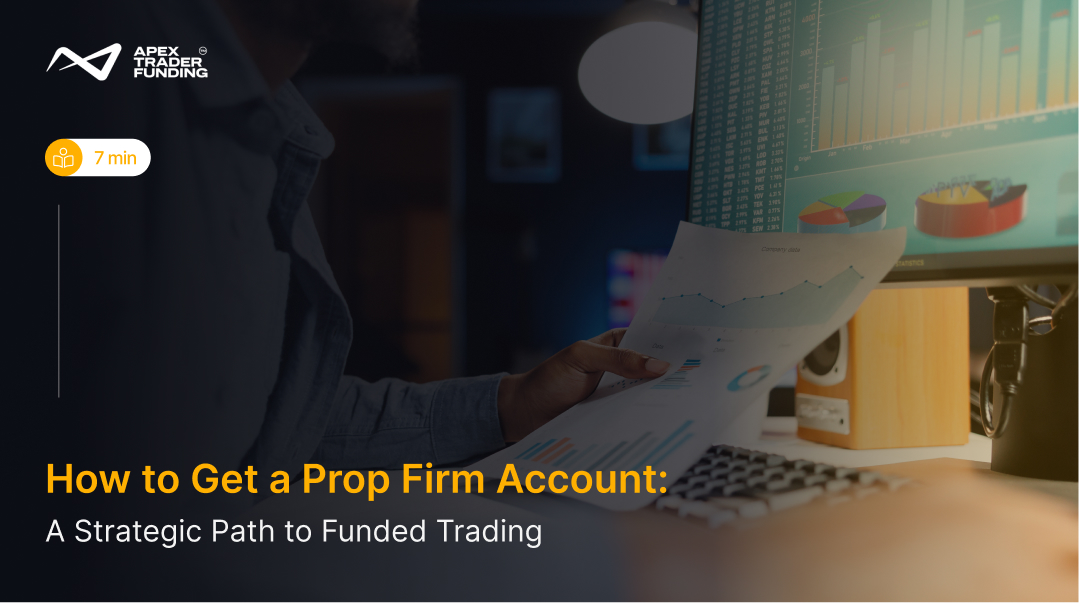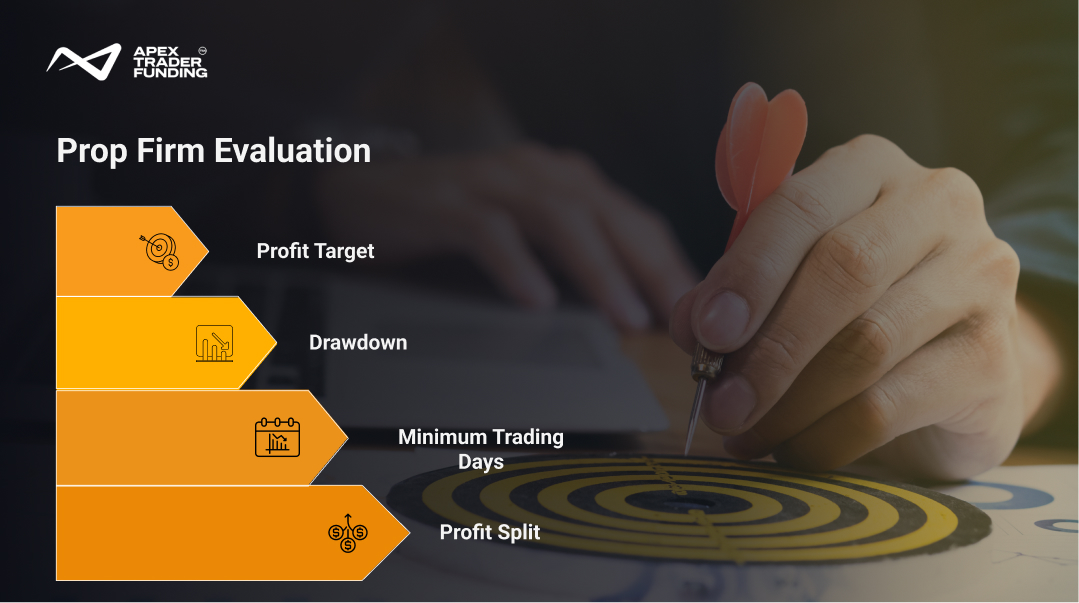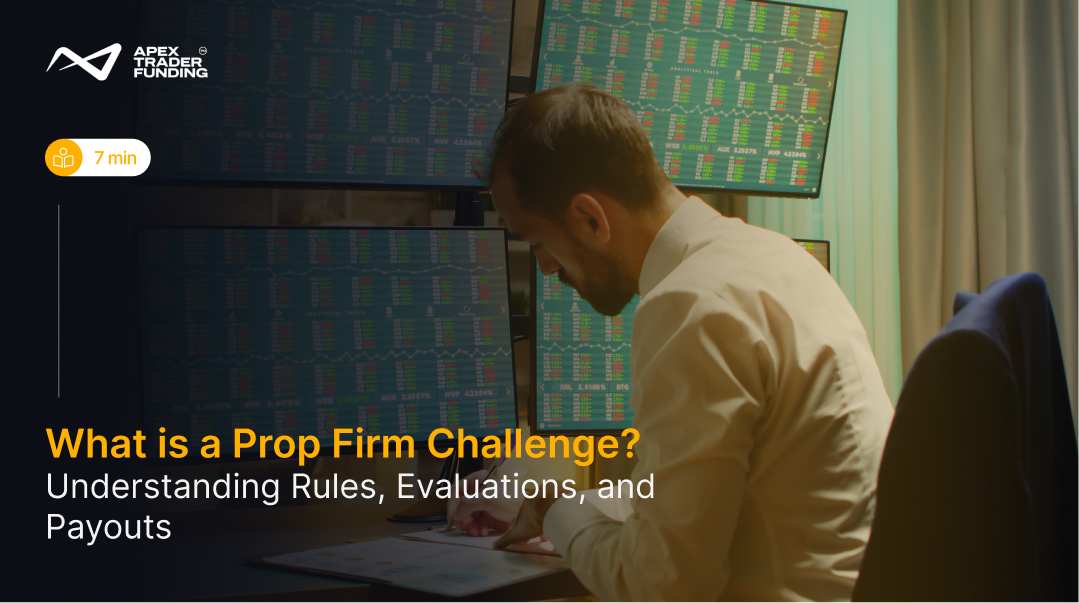
trading-strategies | 29-10-25
Prop firm trading has become one of the most accessible ways to trade larger capital without using your own money. Instead of depositing thousands into a brokerage, traders now prove their skill through structured evaluations to earn a funded account. But getting that account isn’t just about passing a test — it’s about demonstrating control, discipline, and repeatable performance.
This guide explains how to strategically prepare, evaluate, and succeed in earning a prop firm account that supports your trading growth.
How to Get a Prop Firm Account?
Getting a prop firm account starts with registering at a reputable firm and selecting an evaluation plan that matches your goals. Traders must complete the firm’s challenge — reaching a set profit target while following strict rules on drawdown, risk, and minimum trading days. This process proves that you can trade consistently and responsibly under real market conditions.
Once the evaluation is passed, the trader is granted a funded or simulated account, allowing them to trade using the firm’s capital and earn a share of the profits. The key is discipline — prop firms reward consistent, rule-based performance rather than aggressive or impulsive trading.
Here’s how to approach the journey from preparation to funding:
1. Build Strong Trading Foundations
Before applying to any prop firm, you must have the skills to handle real market volatility. Prop firms don’t fund impulsive traders; they fund structured ones.
Start by mastering three essentials:
- Strategy: Focus on a clear trading approach — whether day trading or scalping. Pick one and refine it until you can explain exactly why and when you enter or exit trades.
- Analysis: Learn both technical and fundamental factors. Study charts, indicators, and news events that affect price behavior.
- Risk Management: Use stop-losses and position sizing to protect your equity. The best traders risk only 1–2% of their account per trade.
Once your system works in theory, test it in a demo environment using real-time data. This gives you emotional control and execution discipline — two traits every firm values.
2. Research and Select the Right Prop Firm
Not all prop firms are equal. Some are transparent and trader-focused, while others use confusing rules to generate evaluation fees rather than nurture trading talent.
When comparing firms, focus on:
- Reputation and Reviews: Look for firms with transparent payout records and active trader communities.
- Rule Clarity: Check their drawdown, daily loss, and consistency requirements.
- Platform Options: Ensure compatibility with platforms like Rithmic, Tradovate, or MetaTrader, depending on your strategy.
- Scaling and Payout Terms: Firms like Apex Trader Funding or TopStep often offer scaling plans where you can manage multiple funded accounts once you prove consistency.
Key Metrics in Prop Firm Challenges
This table helps you compare firms and choose one that fits your comfort with risk, pacing, and goals.
3. Pass the Evaluation Phase
The evaluation or challenge phase is where you prove your consistency. Most prop firms use a one- or two-step model.
- Phase 1 – Evaluation: You must reach the profit target while staying within drawdown and loss limits.
- Phase 2 – Verification (if applicable): Often has a smaller profit target but tests whether you can sustain performance without breaking rules.
- Funded Account Stage: After passing, you’ll trade a live or simulated funded account and share profits based on the agreed percentage.
Remember, passing isn’t about being fast — it’s about showing emotional control. Many firms now offer no time limit challenges, allowing you to trade patiently and avoid unnecessary risks.

4. Understand the Cost and Commitment
Every prop firm challenge requires an upfront evaluation fee, which varies based on the virtual account size. Larger accounts cost more but come with bigger payout potential.
Here’s a general idea:
- $25,000 account → around $125–$150
- $50,000 account → around $200–$300
- $100,000 account → around $400–$600
These fees are not deposits; they’re part of the firm’s evaluation system. Once you pass, you can often recoup the fee through your first payout or discounts on future accounts.
5. Trade with Discipline and Consistency
After receiving your funded account, the challenge shifts from proving yourself to maintaining professionalism. Successful traders:
- Trade only when conditions match their plan.
- Keep a trading journal to record decisions and mistakes.
- Avoid emotional overtrading after wins or losses.
- Respect the firm’s daily limits and scaling rules at all times.
Consistency earns trust — and trust earns scaling opportunities. Many firms reward disciplined traders by increasing capital or allowing more simultaneous accounts over time.
“In prop trading, consistency is the real currency — profits follow those who master patience, not those who chase speed.”
6. Instant Funding vs. Challenge Models
Some prop firms offer Instant Funding, where you can trade a funded account immediately after paying a higher upfront fee — no challenge required.
However, these programs:
- Often have stricter drawdowns.
- Offer smaller initial profit splits.
- Are best suited for experienced traders with a proven edge.
Beginners should start with a standard evaluation model to build discipline and gain experience safely.
7. Long-Term Success with Prop Firms
Getting a prop firm account is only the beginning. Sustaining it requires treating trading like a business. View every evaluation as training for professional risk management, not as a shortcut to riches.
Over time, the best traders evolve from “passing challenges” to building consistency-based careers — managing multiple accounts, diversifying strategies, and mastering self-control.
As the saying goes:
“A prop firm doesn’t reward the fastest trader — it rewards the one who lasts.”
Final Thoughts
Earning a prop firm account is about proving discipline, not chasing luck. The process — from preparation to evaluation — trains you to think and act like a professional trader. Focus on skill-building, respect the rules, and let consistency be your edge.
Once you’re ready to take the next step, explore funded account opportunities with reputable firms. You can begin your journey with Apex Trader Funding’s 25K Rithmic or 25K Tradovate accounts — both structured to help you trade confidently with capital that grows with your performance.
FAQs
Getting approved for a prop firm requires proving that you can trade profitably and responsibly under real market conditions. Most firms use an evaluation or challenge phase where you must reach a specific profit target without breaching drawdown or daily loss limits. Meeting the minimum trading days also shows consistency rather than luck. Once you pass, the firm reviews your performance and grants a funded account — allowing you to trade their capital and earn a share of the profits.
The 11 a.m. rule in trading refers to a timing principle that suggests market momentum often slows down around 11 a.m. Eastern Time, especially in U.S. markets. By this point, most of the morning volatility has settled, and traders reassess their positions before the afternoon session. Many day traders use this rule to avoid overtrading during mid-day lulls, lock in early profits, or wait for clearer setups to emerge later in the trading day.
The 30-minute rule in trading suggests waiting at least the first 30 minutes after the market opens before entering new trades. This period is often marked by heightened volatility as traders react to overnight news and institutional orders are executed. By observing price action during this time, traders can identify key support and resistance levels, gauge true market direction, and avoid impulsive trades caused by early-session noise.
Related Blogs

trading-strategies | 27-08-25
How Do Funded Trading Accounts Make Money?
The idea of trading with someone else’s capital has opened doors for thousands of aspiring market participants. Funded trading accounts...
Read more
trading-strategies | 11-09-25
What is a Prop Firm Challenge? - Everything You Need to Know
For aspiring traders, one of the most common gateways into proprietary trading firms is the prop firm challenge. It’s a structured evaluation...
Read more
trading-strategies | 03-10-25
7 Best Prop Trading Firms in Mexico in 2025
Trading in Mexico has evolved into more than just a search for market opportunities — it has become a test...
Read more